1950s
Stabbed by Beauty
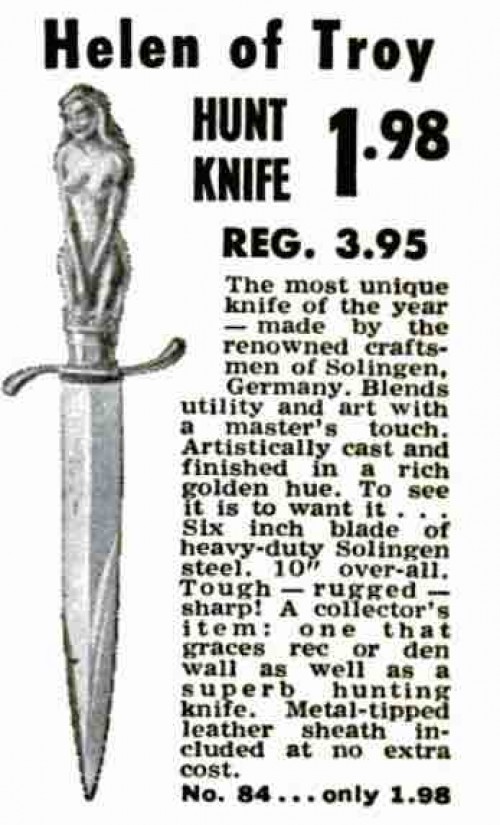
Original ad here.
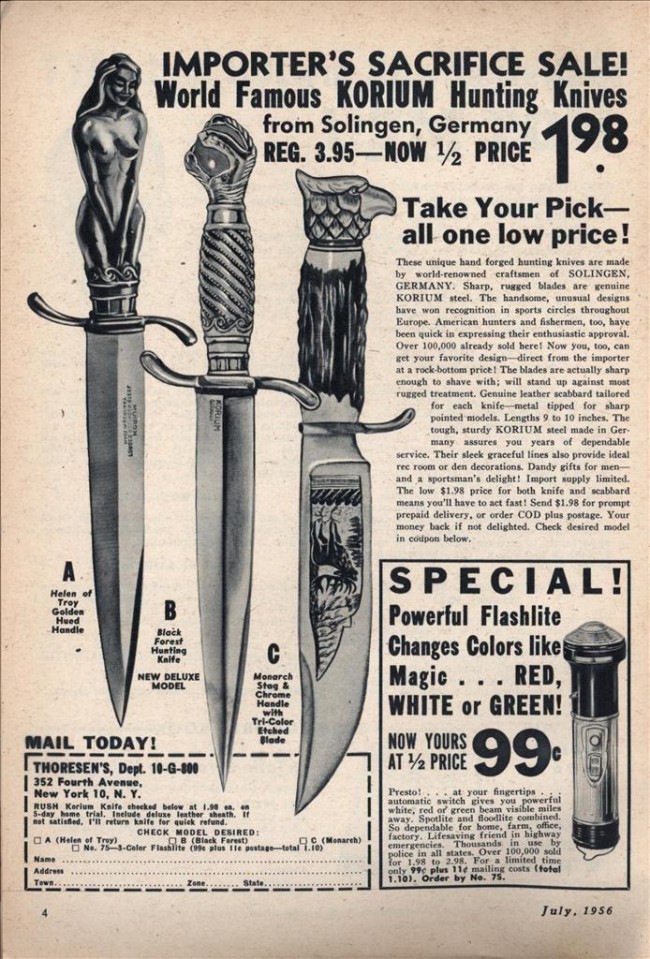
Posted By: Paul - Thu Oct 06, 2016 -
Comments (7)
Category: Beauty, Ugliness and Other Aesthetic Issues, 1950s, Weapons
The Great Scottish Bingo Panic of 1958
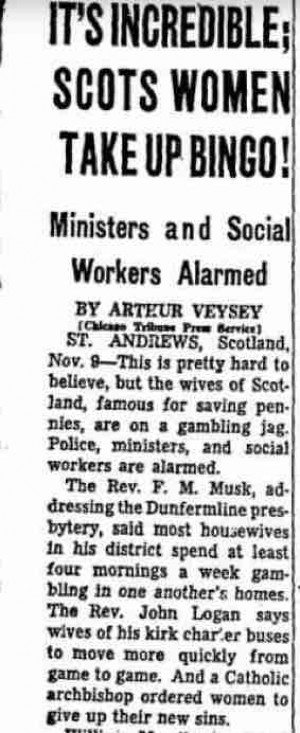
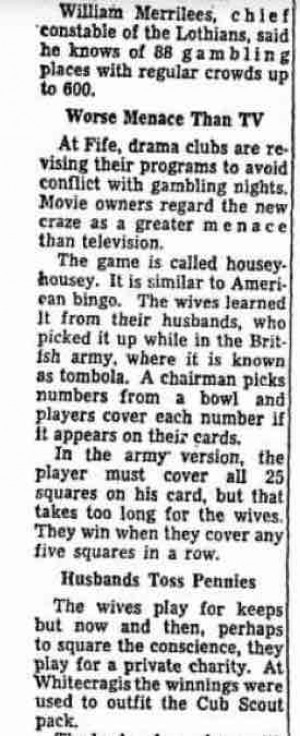
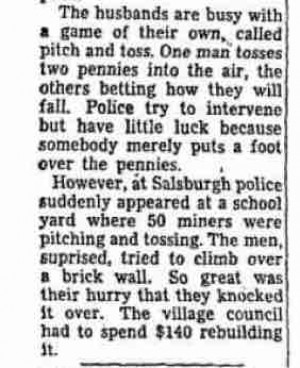

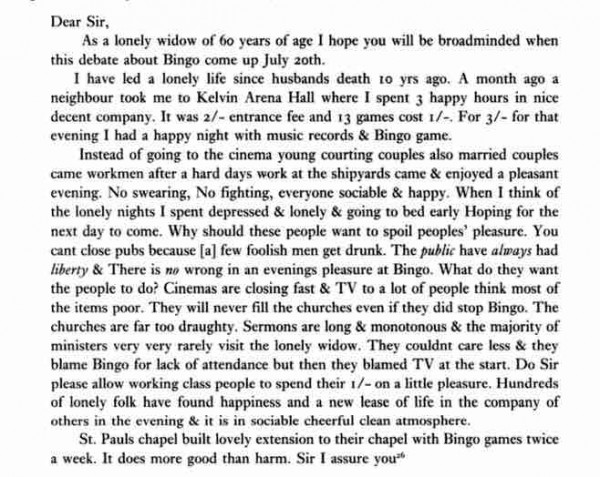
Original text here.
Posted By: Paul - Sun Oct 02, 2016 -
Comments (4)
Category: 1950s, Gambling, Casinos, Lotteries and Other Games of Chance, Europe, Moral Panics and Public Hysteria
LSD for Housewives
Posted By: Paul - Sat Oct 01, 2016 -
Comments (5)
Category: Drugs, Psychedelic, Government, Science, Experiments, 1950s
Follies of the Madmen #294
My favorite part is when this fellow puts his clasped hands to his cheek like a maiden about to faint.
Posted By: Paul - Fri Sep 30, 2016 -
Comments (3)
Category: Business, Advertising, Products, Food, Stereotypes and Cliches, 1950s
Atomic Shave
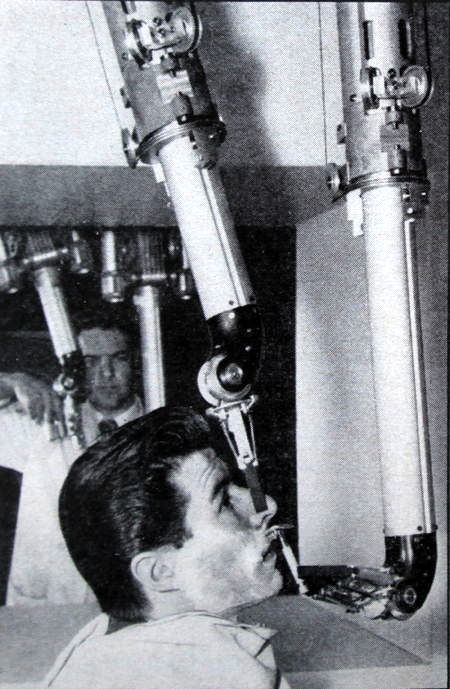
Source: Newsweek - Mar 18, 1957
Posted By: Alex - Thu Sep 29, 2016 -
Comments (6)
Category: 1950s, Hair and Hairstyling
Operation Sleep
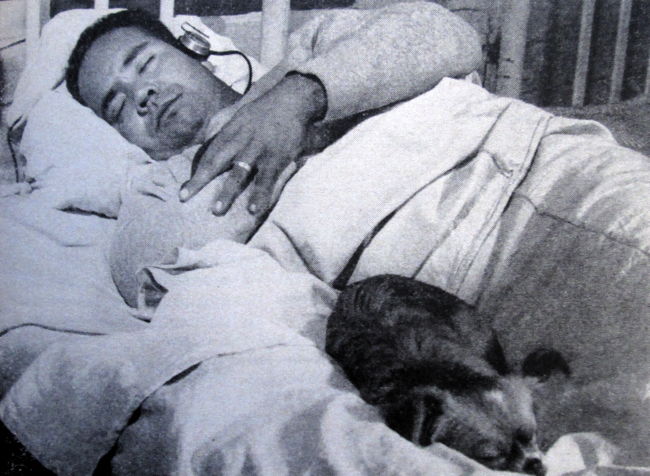
In 1957, the Woodlake road camp prison in California began an experiment in convict rehabilitation. It was called "Operation Sleep." The idea was to use sleep learning to reform convicts. As the prisoners slept, they heard the soothing voice of a psychiatrist speaking the following script:
I am truly happy. I give my life to my family, to my friends, and to the world. I am filled with love and compassion for all, so help me God.
The script had been written by the County's Public Defender, John Locke, with help from a local Presbyterian minister, Rev. Glen Peters, and a hospital therapist, Robert C. Lally. They described Operation Sleep as "a type of brain-washing — but not the type used by the totalitarians."
Unfortunately, there doesn't seem to be any data on whether the experiment actually had an effect of criminal behavior. The superintendent of the prison noted, "We have had excellent cooperation from the inmates. But of course, it is too early yet to tell what effect it will have. We won't know until after the men have been released and face the temptations of freedom again."
The picture at the top is from Newsweek (Dec 30, 1957), and shows one of the prisoners who participated in the experiment. The fact that he's sleeping with a dog seems a little strange. I guess the inmates got to keep pets in this prison.
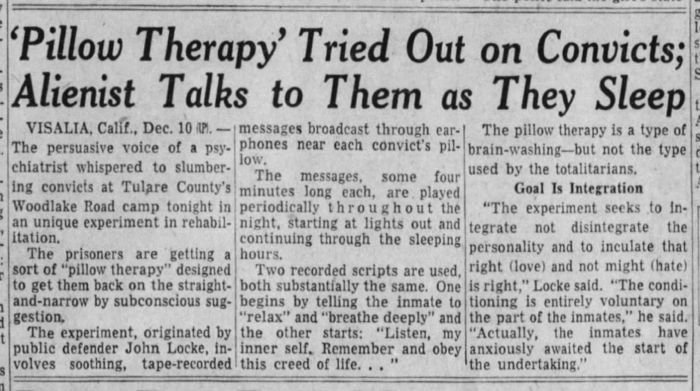
Wilmington Morning News - Oct 11, 1957
Update: I found a news story from 1961 offering a 3-year update on Operation Sleep. I'm actually surprised that the prison kept the experiment going for that long. Public defender John Locke claimed that the experiment had been showing positive results, but said they needed to keep it going for another 3 years to be sure. From the Ottawa Citizen - Feb 21, 1961:
Almost from the beginning though, the guards at the road camps noticed that the young inmates did not cause the same amount of trouble they had created formerly and were surprised when prisoners started coming to them for counsel.
What is probably most indicative of the therapy's effect is the decrease in alcoholism revealed by surveys among ex-prisoners.
Posted By: Alex - Mon Sep 26, 2016 -
Comments (3)
Category: Prisons, Sleep and Dreams, 1950s
You can’t afford not to dress right
In 1957 the American Institute of Men's and Boys' Wear began running print ads that sought to increase sales of men's clothing by using outright shame and scare tactics. Their message to men was that if you don't dress better you'll be a loser and an embarrassment to your family and friends.Playing on social fears had long been a staple in advertising aimed at women, but hadn't really been seen in ads for men — at least, not done so blatantly. So the ads generated quite a bit of controversy. For instance, they prompted the following editorial in the Brownwood Bulletin (Dec 30, 1957):
So they have got themselves organized and are blowing in all kinds of cash trying to educate the menfolks on the value of being properly garbed.
They are running ads, for instance, showing Teenage Daughter appealing tearfully to Mom: "Couldn't Daddy stay upstairs when Jimmy comes for me?" Or Young Husband telling his smock-clad wife, "I didn't get the promotion, Tom did." Or Big Boss saying earnestly, "John we are putting a new man in your territory."
Frankly, I think this is Grade A garbage, and I predict the pants peddlers are going to find the American male is tough to brainwash. Hit him with the slogan, "You can't afford not to dress right," and he'll come back with one of his own: "You can't suit everyone."
In the first place, a lot of men don't care how their clothes look. They are dogs and they are satisified if you toss them an old herringbone now and then. You won't change them any more than you will make a clotheshorse out of the boy who hasn't yet found out that girls can be more interesting than frogs and fishhooks.
In the second place, papa's pocketbook is taking a bigger beating than ever before from the piper, the baker, the hair dresser, the TV repairman, the grocer, etc. He's having to make that 1954 suit do from necessity. And if there should be anything left over, he'd a sight rather blow it on a new spinning reel than an Ivy League jacket.
My advice to the hungry haberdashery huckster is to get out of men's wear into something feminine. Our lady folk, bless them, will buy a bundle of glad rags quicker than you can say "20 per cent off." And Daddy-O will growl but he'll love 'em for it.
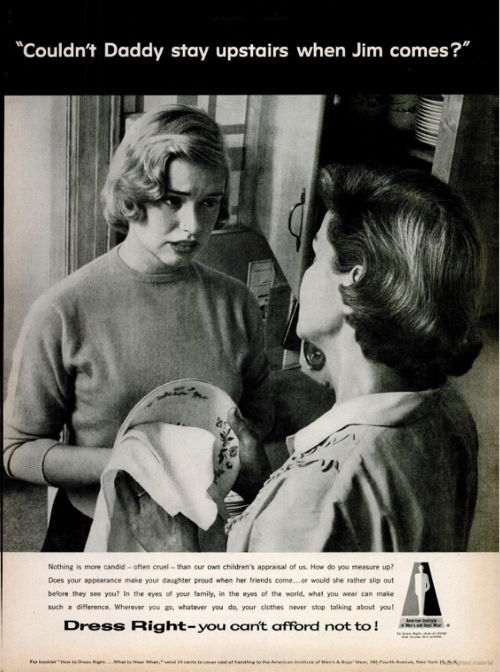
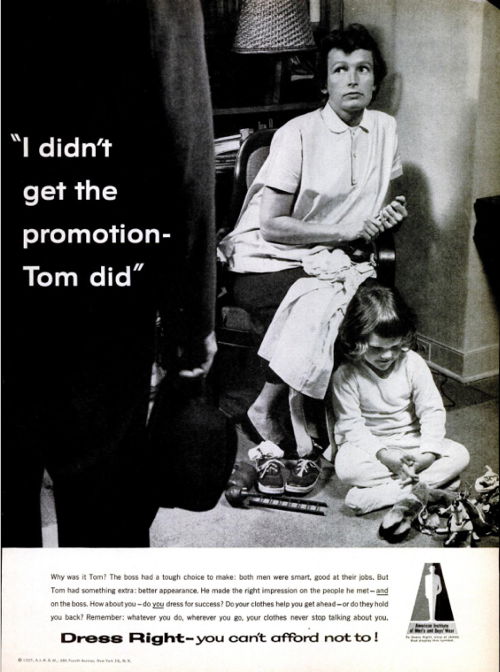
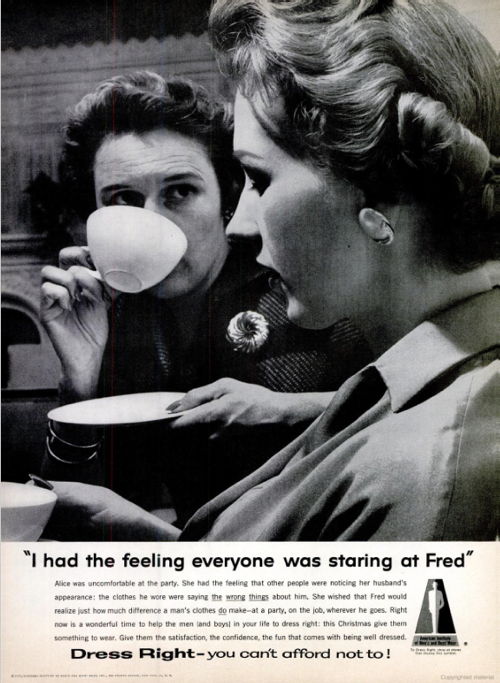
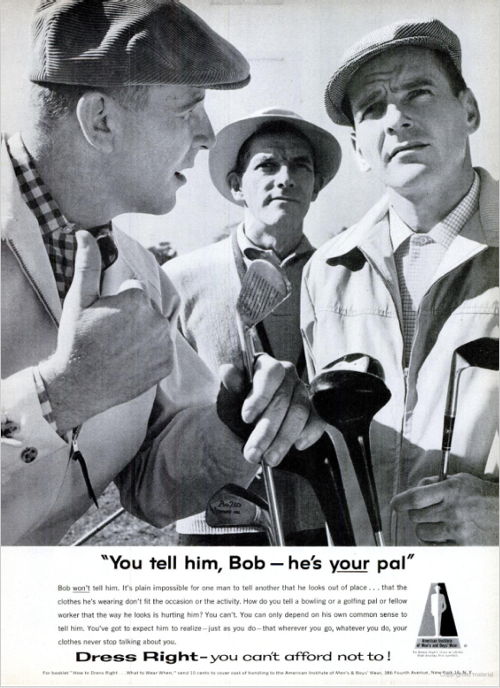
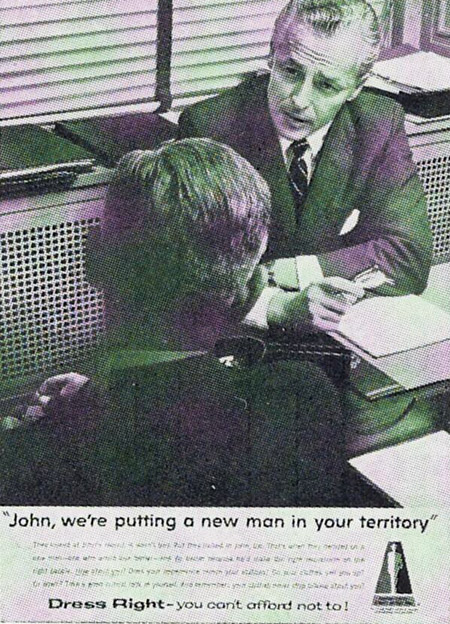
Posted By: Alex - Tue Sep 20, 2016 -
Comments (3)
Category: Advertising, 1950s
Wonder Boy X-100
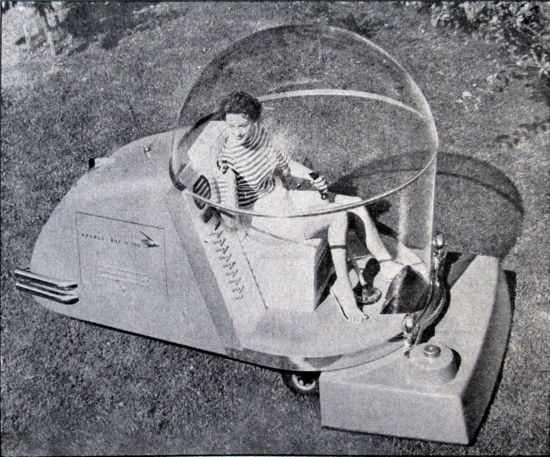
Newsweek - Oct 21, 1957
1957: Simplicity Manufacturing introduced its experimental lawnmower of the future — the Wonder Boy X-100. It could mow, weed, feed, seed, spray, vacuum the lawn, and plow snow, all the while keeping its operator in air-conditioned comfort. It had running lights and an onboard radio-telephone. And the manufacturer noted that it could also be used as a golf cart! It went at a top speed of 10 mph.
I don't think that Simplicity ever produced these for commercial sale.
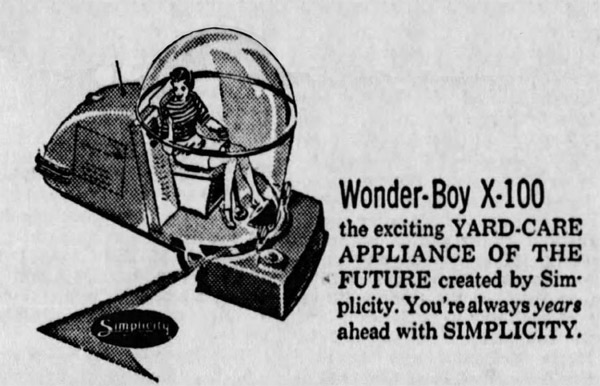

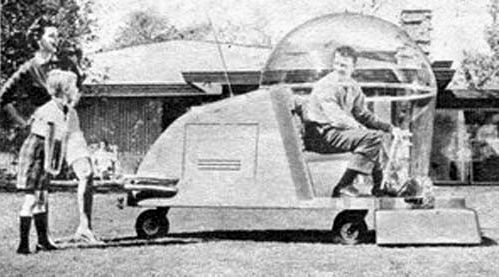

Posted By: Alex - Mon Sep 19, 2016 -
Comments (6)
Category: Inventions, 1950s
Mystery Illustration 31

This portrait is intended to depict what mythical deity? Hint: not an Asian religion.
The answer is here.
Posted By: Paul - Mon Sep 19, 2016 -
Comments (11)
Category: Art, Gods, 1950s
Killed by own invention
That's one way to cure rheumatism.
The Decatur Herald - July 14, 1958
Charles Werly, 52-year-old Swiss inventor, called in a group of specialists Saturday to demonstrate his new electric-wave apparatus for curing rheumatism.
Werly fitted the machine on himself, switched on the current — and died. The watching doctors said he was killed by a 220-volt charge passing through his body.
Posted By: Alex - Wed Sep 14, 2016 -
Comments (7)
Category: Inventions, Experiments, 1950s

| Who We Are |
|---|
| Alex Boese Alex is the creator and curator of the Museum of Hoaxes. He's also the author of various weird, non-fiction, science-themed books such as Elephants on Acid and Psychedelic Apes. Paul Di Filippo Paul has been paid to put weird ideas into fictional form for over thirty years, in his career as a noted science fiction writer. He has recently begun blogging on many curious topics with three fellow writers at The Inferior 4+1. Contact Us |




